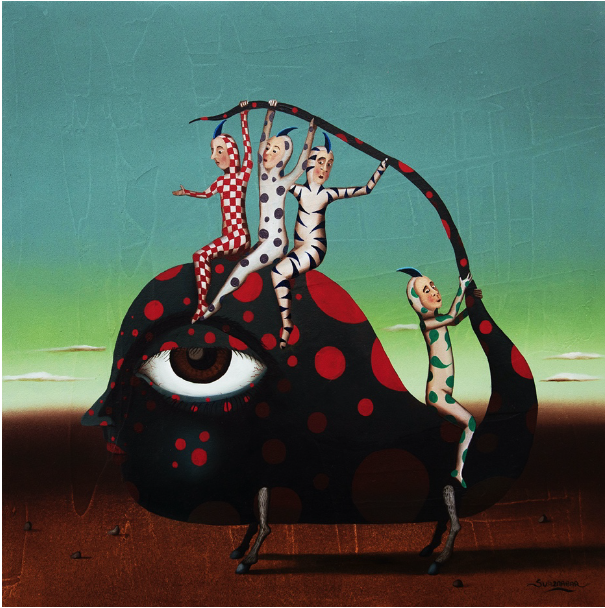|
Monstrous The Pale Blue Knight arrived to a tumultuous welcome. People everywhere were delirious with expectation. Soon the beast which threatened the province would be vanquished and peace restored. The knight’s reward, it was announced, would be the hand of the Governor’s daughter in marriage. ‘May I ask your name?’ asked the Governor, admiring the powder blue suit of armour the knight wore. ‘Cornflower,’ the young man answered. Next day the knight set out for the caves where the beast had its lair. Much had been heard of the monster, its ravaging of crops, theft of livestock, the disappearance of a number of peasants foraging in the woods. But arriving at the caves Cornflower found only a placid, red-spotted creature, about the size of a full-grown hog, with large doleful eyes and a slender tail. The animal offered no resistance when the knight tied a rope around its body and led it away. ‘It’s so pretty,’ declared the Governor’s daughter. ‘Can I keep it as a pet?’ The Governor, who could deny his daughter nothing, acquiesced readily and the animal was taken to the kitchen garden where it was housed in a disused root cellar, the nearest thing they could find to a cave. Its dietary needs were modest, a quantity of hay and a few apples seeming to satisfy it. But the arrival of the creature troubled the administration. Since the Pale Blue Knight had not killed the beast, as required by his contract, it was unclear whether the marriage should go ahead. Some councillors argued that it should, the spirit of the agreement having been met and the threat, albeit an imaginary one, removed. Their opponents claimed that as no danger had actually existed the contract was legally null and void. Cornflower asked the Governor about plans for the wedding and his host blushed, muttered something about ‘minor details needing to be cleared up’, and hurried away. The knight was left to amuse himself as best he could in the Governor’s library. Meanwhile, the daughter was lavishing attention on her new pet, which she had christened Monstrous. Its sadness perplexed her. Though she pampered the animal, nothing seemed to lift its mood. Knowing of her frequent visits to the creature, Cornflower went himself to the root cellar hoping to engage the girl in conversation. But she was so consumed with worry for the animal she scarcely noticed him. Discouraged, the knight crept back to his books. The girl grew melancholy, and the Governor in turn became increasingly despondent. Some councillors began to suspect the creature was not all it seemed. ‘What if the beast allowed itself to be brought here with the intention of plunging everyone into despair?’ one asked. ‘What if Cornflower is in league with the monster?’ another suggested. Some wanted the beast killed, and the knight was proposed as the obvious candidate for executioner. ‘But what about the girl’s health, the risk of her dying of grief?’ several voices demanded. ‘Moreover,’ added another, ‘if Cornflower were to slaughter the favoured pet it’s hard to see how the marriage, even if sanctioned by law, could happily take place.’ Word of these discussions soon found its way to the Pale Blue Knight. Before dawn the next day the sound of hooves and the muffled clank of armour were heard, and in the morning Cornflower was nowhere to be found. In time people began to doubt that he had ever existed. Soon no one remembered why they were sad. The hair of the Governor’s daughter turned cornflower blue as she became more and more stricken with sorrow and the Governor’s whiskers and eyebrows took on a similar hue. Members of the Council were so oppressed by gloomy thoughts they could no longer discharge their duties. From the damp confines of its dilapidated root cellar Monstrous gazed sorrowfully out at the world. Simon Collings Simon Collings lives in Oxford, UK. His poetry, short fiction, translations, reviews and essays have appeared in a wide range of magazines including Stride, Fortnightly Review, Café Irreal, Litter, International Times, Junction Box, The Long Poem Magazine, Ink, Sweat & Tears, PN Review and Journal of Poetics Research. A collection of his prose poems and short fiction, Why are you here?, was published by The Fortnightly Review in November 2020. His third chapbook, Sanchez Ventura, was published by Leafe Press in spring 2021. He is a contributing editor at The Fortnightly Review. More information at: https://simoncollings.wordpress.com/
0 Comments
Your comment will be posted after it is approved.
Leave a Reply. |
The Ekphrastic Review
COOKIES/PRIVACY
This site uses cookies to deliver your best navigation experience this time and next. Continuing here means you consent to cookies. Thank you. Join us on Facebook:
July 2024
|




